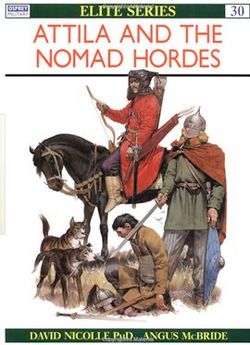Attila The Hun
 From Conservapedia
From Conservapedia Attila was the final and greatest king of the Huns. He nearly conquered the entire Roman Empire. He laid waste to cities in northern Italy, but it is said that he was dissuaded from further bloodshed in the region by Pope Leo I on the shores of Lake Bolsena.[1]
Attila was King of the Huns from A.D. 434 to 453, and he was perhaps the most vicious and barbaric military leader in history. Known as “Attila the Hun,” everyone was completely terrified of him and called him the “Scourge of God.” One rumor was that Attila was a cannibal. He married seven women in his lifetime. The Huns were so barbaric that they did not use fire, and would simply eat raw or semi-raw meat that they found in dead animals. They were extremely fierce in battle. Superb horsemen, the Huns could shoot a bow accurately while riding a horse, benefiting from stirrups that their opponents did not have. The Huns would scream in battle and not follow any system of organized warfare, instead preferring complete chaos on the battlefield. They would fight to the death without any regard for their own safety.
Attila the Hun himself lived a simple life, wearing plain clothes consisting of layered animal skin. An envoy from the Eastern Roman empire who met with Attila once at dinner described it as follows: “By mixing up the languages of the Italians with those of the Huns and Goths, [an entertainer] fascinated everyone and made them break out into uncontrollable laughter, all that is except Attila. He remained impassive, without any change of expression, and neither by word or gesture did he seem to share in the merriment ….” The impression left was that Attila lacked a sense of humor and cared about nothing but power.
As a young warrior, Attila had been sent as a hostage to Rome, then, after he was released by the Romans, he vowed to return to Rome victorious as king. Relying on seers and “gods”, Attila nearly did conquer the Roman Empire. For five years from A.D. 445 to 450 he devastated the eastern Roman empire, destroying anything in his path between the Rhine and the Caspian Sea. In 451 he amassed perhaps the largest army in the history of the world until that time, a total of a half-million men. This army was not just comprised of Huns, but other subject peoples like the Ostrogoths were included. In fact Attila’s name appears to be not his real Hunnish name, but a Gothic nickname meaning ‘Little Father’, given to him by Ostrogothic mercenaries. His horde began riding towards Rome. He quickly conquered Gaul (present-day France) and devastated any European city in his path. He was not stopped until an alliance of the Visigoths and Romans surprised the Huns and forced them to retreat by about a hundred miles. One of the most bloody battles in all of history, the Battle of Chalons, ensued. The Visigoths and Romans defeated the Huns there.
But Attila was clever, and redirected his Huns towards Rome by invading Italy. He was headed towards the heart of the Roman empire: Rome itself. He destroyed everything in his path in the Roman countryside. Unable to stop Attila the Hun by force, a peaceful mission led by Pope Leo I traveled out to meet Attila in 452 and try to persuade him to spare Rome. Moral persuasion worked where violence had not, and Attila did not invade Rome.
A year later, at only age 47, Attila died apparently from a mere nosebleed. It was an ironic cause of death for one of the most feared warriors in the history of the world. Upon his death his empire fell apart with his sons fighting amongst themselves and the people he subjugated rising in rebellion. The Huns disappeared from European history.
See also[edit]
References[edit]
- ↑ Norman Davies - "Europe, A History".
Categories: [Military Commanders] [Medieval History] [Conquerors]
↧ Download as ZWI file | Last modified: 03/27/2023 15:57:12 | 6 views
☰ Source: https://www.conservapedia.com/Attila_the_Hun | License: CC BY-SA 3.0
 ZWI signed:
ZWI signed:

 KSF
KSF